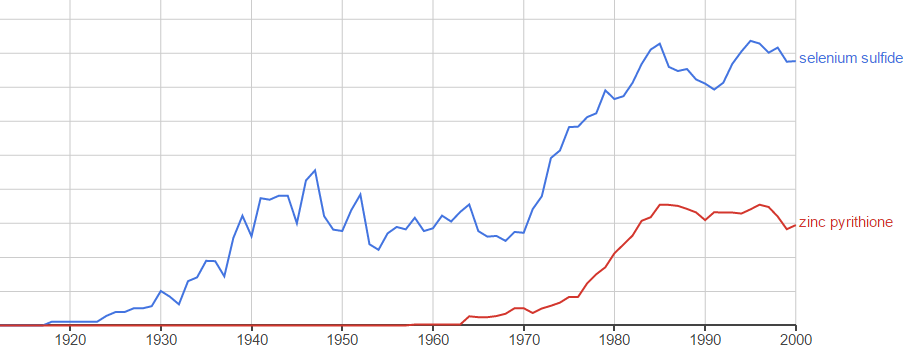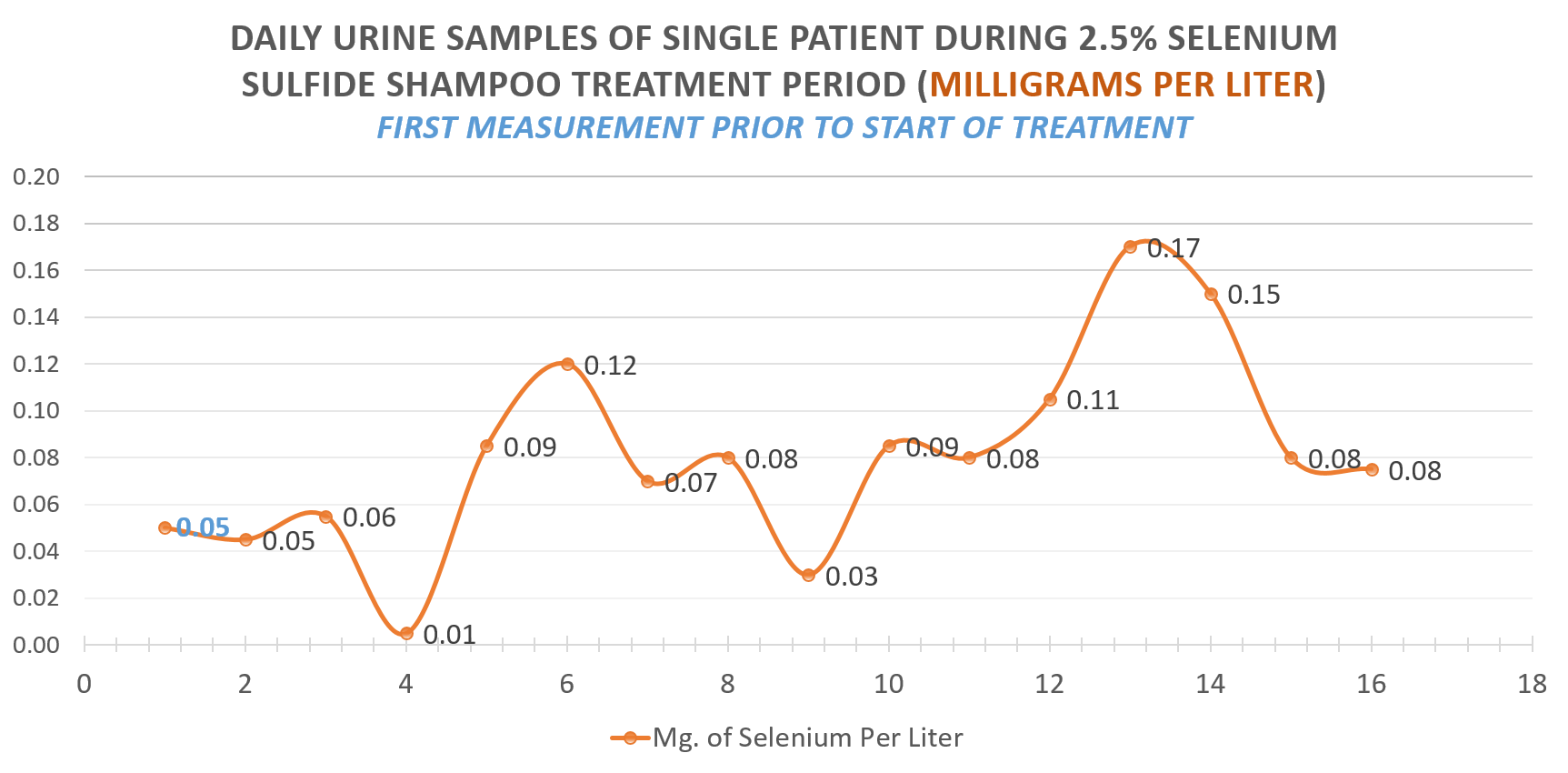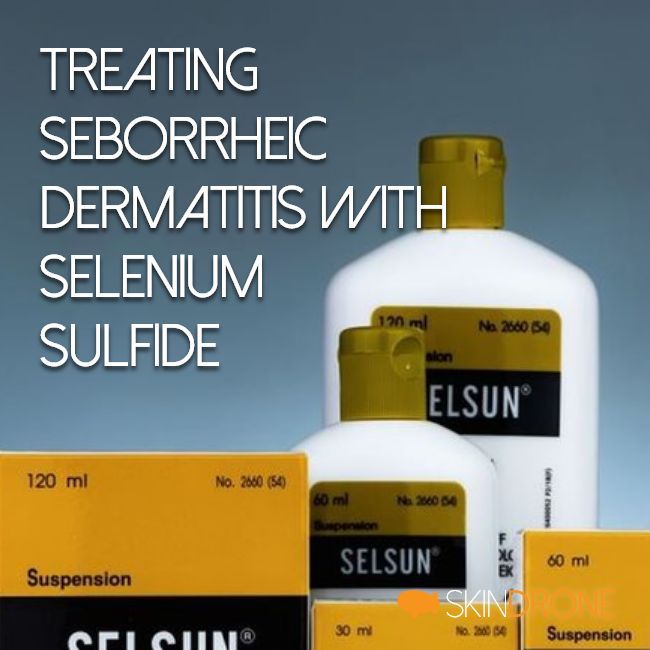Another common antifungal used for treatment of seborrheic dermatitis is selenium sulfide. This active ingredient is recommended only for usage in wash-off formulations, due to toxicity concerns [1].
A Little History on Selenium Sulfide
In the beginning of the 1950s, sulfur was the most prominent treatment choice for seborrheic dermatitis. Though it’s effectiveness was apparent, patients often abandoned treatment prematurely due to excessive greasiness and odor.
Selenium is chemically and physically similar to sulfur. The biggest issue with selenium is it’s toxicity concerns which go back to the 1840s. Regardless of this, it’s similarities with sulfur and favorable aspects (in terms of greasiness and odor) sparked curiosity amongst researchers for it’s usage in seborrheic dermatitis treatment.
In 1951, a group of researches finally decided to study the use of selenium disulfide (commonly referred to simply as selenium sulfide) for the treatment of seborrheic dermatitis [2].
The results of this initial study were generally positive.
Out of the 90 seborrheic dermatitis affected participants tested, 73 (81.1%) showed complete remission during the treatment phase. In majority of cases, optimum results were achieved between the fourth and eight week of treatment.
Regardless of the demonstrated effectiveness, many issues remained around potential toxicity issues. And a significant part of this study was devoted to examining the level of selenium absorption through the skin.
In the end, it seems the effectiveness and favorable usage characteristics outweighed the toxicity concerns. The research continued and selenium sulfide became one of the most popular seborrheic dermatitis shampoos to date.

How Selenium Sulfide is Believed to Relieve Seborrheic Dermatitis
Three possible mode of action are known:
- Antifungal activity against malassezia
- Toxic effect on keratinocytes
- Peeling outer layer of skin
The majority of research attributes it’s effectiveness to it’s antifungal activity against various malassezia yeasts [3]. But other beneficial properties have been observed.
One of these other properties is the toxic effect it has on keratinocytes (unique epidermal skin cells) [4]. Which results in a reduced rate of cell division and growth. This may seem unfavorable, but an abnormally high rate of cell division (of these keratinocytes) is believed to be one the fundamental issues in seborrheic dermatitis [5].
The third property, is it’s potential to soften and shed (peel) the outer layer of the skin [6]. The result is a potentially more rapid removal top layer of skin (affected by seborrheic dermatitis).
Selenium Sulfide Safety Concerns
Even though selenium sulfide works well for controlling seborrheic dermatitis, selenium is an established toxicant [7]. And various safety concerns exist for the long term usage of selenium sulfide [8].
The consensus appears to be that selenium sulfide is one of the least toxic selenium compounds. Which has been attributed to it’s low aqueous solubility (does not dissolve well into water) which results in poor topical absorption [9].
One study that examined the weekly usage of selenium sulfide for a full year showed normal urinary selenium levels [7]. These results imply that significant amounts of selenium are not absorbed through the skin. This study was limited to 16 participants using a 1% selenium sulfide shampoo only once a week.

In another study of 140 individuals over the course of 2 years, no toxic effects were reported [1]. However, after 3-4 weeks, 43 (31%) participants reported excessive sebaceous gland secretions.
Some less common negative side effects have also been reported:
- Diffuse hair loss after regular usage [10]
- Cases of contact dermatitis [11]
- Abnormal development of hair roots has been observed in prolonged exposure [12]
Overall, selenium sulfide seems to present more safety concerns and possible adverse reactions then some of the newer antifungals (ketoconazole, zinc pyrithione, clotrimazole).
How it Compares to Other Antifungals
In a study of 246 individuals, 2% ketoconazole was shown to be superior to 2.5% selenium sulfide [13]. And out of a total of 9 adverse experiences reported, all 9 were from those treated with selenium sulfide.
In a lab setting, 2% ketoconazole was shown to be at least 10x more effective at at destroying Malassezia furfur then 1% selenium sulfide (the most commonly used concentration) [3].
In a study done on guinea pigs, both 2% zinc pyrithione and 2% ketoconazole had superior antifungal activity (against malassezia) then 2.5% selenium sulfide [14]. Ketoconazole showed the strongest inhibition, while zinc pyrithione was only marginally better then selenium sulfide.
Different Studies Use Different Concentrations
The above study used all three common antifungal agents at concentrations much higher then those most commonly available.
Section Summary
This section evaluated the usage of selenium sulfide as a potential treatment for seborrheic dermatitis. Here are some of the key highlights:
- Selenium sulfide is a popular seborrheic dermatitis treatment commercially available only in wash-off formulations.
- It was initially introduced as replacement for sulfur due to it’s similarities and lack of adverse usage characteristics (oiliness and smell).
- It’s main mechanism of action in relieving seborrheic dermatitis is believed to come from it’s antifungal potential against malassezia yeasts.
- Other properties which may be beneficial to seborrheic dermatitis include it’s toxic effect to keratinocytes and it’s skin peeling effect.
- Sulfide is a known toxicant and a significant amount of safety concerns exist for the long term usage of selenium sulfide.
- Research has demonstrated selenium sulfide’s safety and attributed this to to low absorbability into the skin, but prolonged contact is never recommended.
- Newer antifungals appear to have higher treatment success rates and a lower possibility of adverse reactions.

No Comments
Be the first to start a conversation